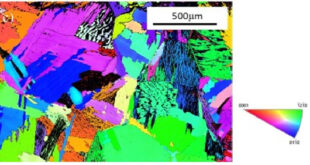Significance Statement
Controlling the heating conditions, cooling rate, forming speed and metallic sheet temperature under hot stamping is very critical in achieving successful forming. The forming limit diagram is a conventional and useful tool to evaluate the formability of sheet metals. The research team explained that the shape of the forming limit diagram of a material formed at elevated temperatures varies greatly from the one formed at room temperature. The team said the determination of forming limit curves at elevated temperatures depend on isothermal or same temperature testing condition, constant strain rate and proportional strain paths. There are different types of formability tests for testing forming limit diagram for sheet metals. The out-of-plane test and the in-plane test are the most commonly used methods to determine limit strains. However, it is hard to obtain a forming limit diagram of a material under hot stamping and cold die quenching conditions.
Dr. Zhutao Shao and his colleagues from Imperial College London and Professor Trevor Dean from University of Birmingham have developed a new biaxial testing system for generating forming limit diagrams for sheet metal under hot stamping conditions. The research work is now published in Experimental Mechanics, International Journal of Mechanical Sciences, and Journal of Visualized Experiments (JoVE).
In view of obtaining the forming limit diagram of a material at hot stamping conditions, the research team developed a new biaxial testing system based on the Gleeble thermo-mechanical materials simulator; in addition, thermal analysis of the resistance heating and air cooling methods was included to realize complex testing conditions and to improve the uniformity of temperature distribution of the specimen during testing. To capture the speckled pattern on the central area of the specimen, they used high speed camera with the DIC system, and ARIMIS software was used in data processing to obtain the strain field of time-dependent deformation of the specimen.
The thermo-electrical FE model was used to investigate the temperature distribution of the testing specimen. Results were analyzed by comparing temperature distribution obtained from different types of resistance heating and air cooling strategies. Cruciform specimens were developed for this specific formability test by the research team after the thermal analysis. When the researchers carried out tests by using the novel in-plane biaxial tensile testing system, they found that the average temperature in the central region of the specimen is higher than that of the arms of the specimen, which can ensure fracture to occur in the central gauge region of the specimen.
This study developed a biaxial testing system which was able to generate forming limit diagrams for sheet metals under hot stamping conditions. It was concluded that selecting two adjacent arms of the cruciform specimen to positive electrode gave the most acceptable temperature field within the gauge region. This new method can be used to evaluate the formability of many sheet metals up to 1000°C based on a Gleeble materials simulator.
Quotes/comments from the authors:
“The main advantage of this technique is that it enables forming limits of sheet metals to be determined experimentally under complex forming conditions. Generally, conventional formability tests are not applicable to hot stamping for two reasons: first, the cooling process occurs prior to deformation and, second, controlling the forming parameters is very difficult” Said Dr Zhutao Shao.
“We were the first in the field to have the idea of using a novel biaxial testing system to measure forming limits under complex forming conditions” Said Professor Jianguo Lin.
“Based on the developed system, forming limits of other sheet metals like magnesium alloy or boron steel, can also be measured under hot stamping conditions” said Dr Nan Li.

References
Z. Shao1, N. Li1, J. Lin1 and T. A. Dean2, Development of a new Biaxial Testing System for Generating Forming Limit Diagram for Sheet Metals under hot Stamping Conditions, Experimental Mechanics (2016) 56:1489–1500.
[expand title=”Show Affiliations”]1 Department of Mechanical Engineering, Imperial College London, London, UK.
2. School of Mechanical Engineering, University of Birmingham, Birmingham, UK.
[/expand]Go To Experimental Mechanics
Z. Shao, N. Li, J. Lin, T. A. Dean, Formability evaluation for sheet metals under hot stamping conditions by a novel biaxial testing system and a new materials model, International Journal of Mechanical Sciences, (2017) 120: 149-158.
Shao, Z., Li, N. A Novel Biaxial Testing Apparatus for the Determination of Forming Limit under Hot Stamping Conditions. J. Vis. Exp. (122), e55524, doi:10.3791/55524 (2017).
 Advances in Engineering Advances in Engineering features breaking research judged by Advances in Engineering advisory team to be of key importance in the Engineering field. Papers are selected from over 10,000 published each week from most peer reviewed journals.
Advances in Engineering Advances in Engineering features breaking research judged by Advances in Engineering advisory team to be of key importance in the Engineering field. Papers are selected from over 10,000 published each week from most peer reviewed journals.




